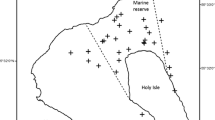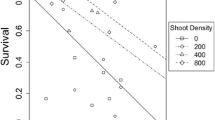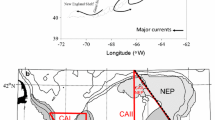Abstract
This study investigated the effects of a fully protected marine reserve on commercially valuable scallops and benthic habitats in Lamlash Bay, Isle of Arran, United Kingdom. Dive surveys found the abundance of juvenile scallops to be greater within the marine reserve than outside. A novel multivariate approach, based upon neural networks and generalised linear models, revealed the greater abundance of juveniles to be related to the greater presence of macroalgae and maerl within the reserve boundaries. This complex habitat appeared to have positively encouraged spat settlement. In contrast, the density of adult scallops did not differ between the two treatments, possibly due to the short duration of protection. However, the age, size and biomass of adult scallops were significantly greater within the reserve. Overall, this study suggests that the newly created marine reserve is already providing benefits which are flowing back to species targeted by fisheries, emphasising the importance of marine reserves in ecosystem-based management of fisheries.







Similar content being viewed by others
References
Adams VM, Mills M, Jupiter SD, Pressey RL (2010) Improving social acceptability of marine protected area networks: a method for estimating opportunity costs to multiple gear types in both fished and currently unfished areas. Biol Conserv. doi:10.1016/j.biocon.2010.09.012
Airoldi L, Balata D, Beck MW (2008) The Gray Zone: relationships between habitat loss and marine diversity and their applications in conservation. J Exp Mar Biol Ecol 366:8–15
Auster PJ, Malatesta RJ, Langton RW, Watling L, Valentine PC, Donaldson CLS, Langton EW, Shepard EN, Babb IG (1996) The impacts of mobile fishing gear on seafloor habitats in the Gulf of Maine (Northwest Atlantic): implications for conservation of fish populations. Rev Fish Sci 4:185–202
Axelsson M, Dewey S, Plastow L, Doran J (2009). Mapping of marine habitats and species within the Community Marine Conservation Area at Lamlash Bay. Scottish Natural Heritage Commissioned Report No. 346
Barnes M (2009) BIOTIC Species Information for Aequipecten opercularis. http://www.marlin.ac.uk/biotic. Accessed 9 October 2010
Baxter JM, Boyd IL, Cox M, Cunningham L, Holmes P, Moffat CF (2008) Scotland’s seas: towards understanding their state. Fisheries Research Services, Aberdeen
Beck MW, Heck KL, Able KW, Childers DL, Eggleston DB, Gillanders BM, Halpern B, Hays CG, Hoshino K, Minello TJ, Orth RJ, Sheridan PF, Weinstein MR (2001) The identification, conservation, and management of estuarine and marine nurseries for fish and invertebrates. Bioscience 51:633–641
Berkeley SA, Hixon MA, Larson RJ, Love MS (2004) Fisheries sustainability via protection of age structure and spatial distribution of fish populations. Fish 29:23–32
Beukers-Stewart BD, Beukers-Stewart JS (2009) Principles for the management of inshore scallop fisheries around the United Kingdom. Report to Natural England, Countryside Council for Wales and Scottish Natural Heritage. University of York
Beukers-Stewart BD, Jenkins SR, Brand AR (2001) The efficiency and selectivity of spring-toothed scallop dredges: a comparison of direct and indirect methods of assessment. J Shellfish Res 20:121–126
Beukers-Stewart BD, Mosley MWJ, Brand AR (2003) Population dynamics and predictions in the Isle of Man fishery for the great scallop (Pecten maximus L). ICES J Mar Sci 60:224–242
Beukers-Stewart BD, Vause BJ, Mosley MWJ, Rossetti HL, Brand AR (2005) Benefits of closed area protection for a population of scallops. Mar Ecol Progr Ser 298:189–204
Beukers-Stewart BD, Vause BJ, Mosley MWJ, Rossetti HL, Brand AR (2006) Closed areas and stock enhancement of scallops: what’s the catch? J Shellfish Res 25:267–268
Bradshaw C, Veale LO, Hill AS, Brand AR (2001) The effect of scallop dredging on Irish Sea benthos: experiments using a closed area. Hydrobiologia 1–3:129–138
Bradshaw C, Collins P, Brand AR (2003) To what extent does upright sessile epifauna affect benthic biodiversity and community composition? Mar Biol 143:783–791
Brand AR (2006a) The European scallop fisheries for Pecten maximus, Aequipecten opercularis and Mimachlamys varia. In: Shumway S, Parsons GJ (eds) Scallops: biology, ecology and aquaculture. Elsevier, Amsterdam
Brand AR (2006b) Scallop ecology: distributions and behaviour. In: Shumway S, Parsons GJ (eds) Scallops: biology, ecology and aquaculture. Elsevier, Amsterdam
Brand AR, Paul JD, Hoogesteger JN (1980) Spat settlement of the scallops Chlamys opercularis (L.) and Pecten maximus (L.) on artificial collectors. J Mar Biol Assoc UK 60:379–390
Brand AR, Wilson UAW, Hawkins SJ, Allison EH, Duggan EH (1991) Pectinid fisheries, spat collection, and the potential for stock enhancement in the Isle of Man. ICES Mar Sci Symp 192:79–86
Cacabelos E, Olabarria C, Incera M, Troncoso JS (2010) Effects of habitat structure and tidal height on epifaunal assemblages associated with macroalgae. Estuar Coast Shelf Sci 89:43–52
Charlotte M, Wilson E (2009) Pecten maximus. Great scallop. Marine life information network: biology and sensitivity key information sub-programme. Plymouth: marine biological association of the United Kingdom. http://www.marlin.ac.uk/speciessensitivity.php?speciesID=4056. Accessed 18 October 2010
Christie H, Jørgensen NM, Norderhaug KM (2007) Bushy or smooth, high or low; importance of habitat architecture and vertical position for distribution of fauna on kelp. J Sea Res 58:198–208
Claereboudt C (1999) Fertilization success in spatially distributed populations of benthic free-spawners: a simulation model. Eco Models 12:221–233
Collie JS, Escanero GA, Valentine PC (1997) Effects of bottom fishing on the benthic megafauna of Georges bank. Mar Ecol Progr Ser 155:159–172
Community of Arran Seabed Trust (COAST, 2005) The Arran marine regeneration trial. Proposal of a community-based marine protected area. http://www.arrancoast.com/Archives/proposal.pdf. Accessed 22 November 2010
Connor DW, Allen JH, Golding N, Howell KI, Lieberknecht LM, Northen KO, Reker JB (2004) The marine habitat classification for Britain and Ireland version 04.05. JNCC, Peterborough
Conover WJ (1999) Practical nonparametric statistics. Wiley, West Sussex
Crawley MJ (2005) Statistics: an introduction using R. Wiley, West Sussex
Dayton PK, Thrush SF, Agardy TM, Hofman RJ (1995) Environmental effects of marine fishing. Aquat Conserv Mar Freshw Ecosyst 5:205–232
Demuth H, Beale M (2001) Neural network toolbox user’s guide. Matlab user’s guide. The MathWorks Inc, Natick
Duncan C (2003) Lamlash Bay Seasearch 2003. Interim report by the Marine Conservation Society to Scottish Natural Heritage
Edgar GJ, Barrett NS (1999) Effects of the declaration of marine reserves on Tasmanian reef fishes, invertebrates and plants. J Exp Mar Biol Ecol 242:107–144
Eleftheriou A, Robertson MR (1992) The effects of experimental scallop dredging on the fauna and physical environment of a shallow sandy community. Neth J Sea Res 30:289–299
Gaines SD, Gaylord B, Largier JL (2003) Avoiding current oversights in marine reserve design. Ecol Appl 13:S32–S46
Gell FR, Roberts CM (2002) The fishery effects of marine reserves and fishery closures. WWF, Washington
Gell FR, Roberts CM (2003) Benefits beyond boundaries: the fishery effects of marine reserves. Trends Ecol Evol 18:448–455
Gibb FM, Gib IM, Wright PJ (2007) Isolation of Atlantic cod (Gadus morhua) nursery areas. Mar Biol 151:1185–1194
Grantham BA, Eckert GL, Shanks AL (2003) Dispersal potential of marine invertebrates in diverse habitats. Ecol Appl 13:S108–S116
Hall-Spencer JM, Moore PG (2000) Scallop dredging has profound, long-term impacts on maerl habitats. ICES J Mar Sci 57:1407–1415
Hall-Spencer J, White N, Gillespie E, Gillham K, Foggo A (2006) Impact of fish farms on maerl beds in strongly tidal areas. Mar Ecol Progr Ser 326:1–9
Halpern BS (2003) The impact of marine reserves: do reserves work and does reserve size matter? Ecol Appl 13:S117–S137
Halpern BS, Warner RR (2002) Marine reserves have rapid and lasting effects. Ecol Lett 5:361–366
Halpern BS, Lester SE, McLeod KL (2010) Placing marine protected areas onto the ecosystem based management seascape. Proc Natl Acad Sci USA. doi:10.1073/pnas.0908503107
Haykin SS (1994) Neural networks: a comprehensive foundation. MacMillan, New York
Haykin SS (2009) Neural networks and learning machines, 3rd edn. Pearson Education, New Jersey
Howell TRW, Fraser DI (1984) Observations on the dispersal and mortality of the scallop Pecten maximus (L.). ICES Council Shellfish Committee, CM 1984/K35
Howell TRW, Davis SEB, Donald J, Dobby H, Tuck I, Bailey N (2006) Report of Marine Laboratory Scallop Stock Assessments. Report No. 08/06, Fisheries Research Services
Japp DW, Wilkinson S (2007) Deep-sea resources and fisheries. In: FAO (2007) Report and documentation of the Expert Consultation on Deep-sea Fisheries in the High Seas. FAO Fisheries Report No. 838, Rome
Jennings S, Kaiser MJ (1998) The effects of fishing on marine ecosystems. Adv Mar Biol 34:201–351
Jennings S, Kaiser MJ, Reynolds JD (2001) Marine fisheries ecology. Blackwell Science, Oxford
Kaiser MJ, Spence FE, Hart PJB (2000) Fishing-gear restrictions and conservation of benthic habitat complexity. Conserv Biol 14:1512–1525
Kaiser MJ, Clarke KR, Hinz H, Austen MCV, Somerfield PJ, Karakassis I (2006) Global analysis of response and recovery of benthic biota to fishing. Mar Ecol Progr Ser 311:1–14
Kaiser MJ, Blyth-Skyrme RE, Hart PJB, Edwards-Jones G, Palmer D (2007) Evidence for greater reproductive output per unit area in areas protected from fishing. Can J Fish Aquat Sci 64:1284–1289
Kamenos NA, Moore PG, Hall-Spencer JM (2004a) Attachment of the juvenile queen scallop (Aequipecten opercularis (L.)) to maerl in mesocosm conditions; juvenile habitat selection. J Exp Mar Biol Ecol 306:139–155
Kamenos NA, Moore PG, Hall-Spencer JM (2004b) Nursery-area function of maerl grounds for juvenile queen scallops Aequipecten opercularis and other invertebrates. Mar Ecol Progr Ser 274:183–189
Kamenos NA, Moore PG, Stevenson TDI (2004c) Marine survey to identify maerl beds: Lamlash Bay long sea outfall. Scottish Water Solutions Ref Num: SWS/FW/2004–0427 -01. University Marine Biological Station Millport, Isle of Cumbrae
Laurel BJ, Ryer CH, Knoth B, Stoner AW (2009) Temporal and ontogenetic shifts in habitat use of juvenile Pacific cod (Gadus macrocephalus). J Exp Mar Biol Ecol 377:28–35
Le Pennec M, Paugam A, Le Pennec G (2003) The pelagic life of the pectinid Pecten maximus—review. ICES J Mar Sci 60:211–223
Lewis CVW, Lynch DR, Fogarty MJ, Mountain D (2001) Effects of area closures on Georges Bank bivalves: larval transport and population dynamics. www.nml.dartmouth.edu/Publications/internal_reports/NML-00-2/. Accessed 31 August 2010
Link J (2002) What does ecosystem-based fisheries management mean? Fisheries 27:18–21
Macleod JAA, Thorpe JP, Duggan NA (1985) A biochemical genetic study of population structure in queen scallop (Chlamys opercularis) stocks in the Northern Irish Sea. Mar Biol 87:77–82
Marshall C, Wilson E (2009) BIOTIC Species Information for Pecten maximus. http://www.marlin.ac.uk/biotic. Accessed 20 November 2010
Mason J, Drinkwater J, Howell TRW, Fraser DI (1982) A comparision of methods of determining the distribution and density of the scallop, Pecten maximus (L.) ICES CM1982/K: 24
McClanahan TR, Mangi S (2000) Spillover of exploitable fishes from a marine park and its effect on the adjacent fishery. Ecol Appl 10:1792–1805
Minchin D (1992) Biological observations on young scallops, Pecten maximus. J Marine Biol Assoc UK 72:807–819
Monteiro SM, Chapman MG, Underwood AJ (2002) Patches of the ascidian Pyura stolonifera (Heller, 1878): structure of habitat and associated intertidal assemblages. J Exp Mar Biol Ecol 270:171–189
Murawski SA, Brown R, Lai H-L, Rago PJ, Hendrickson L (2000) Large-scale closed areas as a fishery-management tool in temperate marine systems: the Georges Bank experience. Bull Mar Sci 66:775–798
Myers RA, Fuller SD, Kehler DG (2000) A fisheries management strategy robust to ignorance: rotational harvest in the presence of indirect fishing mortality. Can J Fish Aquat Sci 57:2357–2362
Paul JD (1981) Natural settlement and early growth of spat of the queen scallop Chlamys opercularis (L.), with reference to the formation of the first growth ring. J Molluscan Stud 47:53–58
Pelc RA, Warner RR, Gaines SD, Paris CB (2010) Detecting larval export from marine reserves. Proc Natl Acad Sci USA. doi:10.1073/pnas.0907368107
Peterson CH, Summerson HC (1992) Basin-scale coherence of population dynamics of an exploited marine invertebrate, the bay scallop: implications of recruitment limitation. Mar Eco Progr Ser 90:257–272
Pikitch EK, Santora C, Babcock EA, Bakun A, Bonfil R, Conover DO, Dayton P, Doukakis P, Fluharty D, Heneman B, Houde ED, Link J, Livingston PA, Mangel M, McAllister MK, Pope J, Sainsbury KJ (2004) Ecosystem-based fishery management. Science 305:346–347
Rago P, McSherry M (2002) Spatial distribution of fishing effort for sea scallops: 1998–2000. Appendix G in Northeast Region Essential Fish Habitat Steering Committee, Workshop on the Effects of Fishing Gear on Marine Habitats off the Northeastern United States. 23–25 October 2001. NOAA, Woods Hole, Massachusetts. http://www.nefsc.noaa.gov/nefsc/publications/crd/crd0201/appg.pdf. Accessed 31 August 2010
Rice MA, Hickox C, Zehra I (1989) Effects of intensive fishing effort on the population structure of quahogs, Mercenaria mercenaria (Linnaeus 1758), in Narragansett Bay. J Shellfish Res 8:345–354
Roberts CM, Hawkins JP (2000) Fully-protected marine reserves: a guide. WWF endangered seas campaign. USA and Environment Department, Washington
Roberts CM, Polunin NVC (1991) Are marine reserves effective in the management of reef fisheries? Rev Fish Biol Fish 1:65–91
Roberts CM, Bohnsack JA, Gell F, Hawkins JP, Goodridge R (2001) Effects of marine reserves on adjacent fisheries. Science 294:1920–1923
Roberts CM, Hawkins JP, Gell FR (2005) The role of marine reserves in achieving sustainable fisheries. Philos Trans R Soc Lond B 360:123–132
Royston JP (1982) The W Test for Normality. Appl Stat 31:176–180
Ryer CH, Stoner AW, Titgen RH (2004) Behavioural mechanisms underlying the refuge value of benthic habitat structure for two flatfishes with differing antipredator strategies. Mar Ecol Progr Ser 268:231–243
Sewell J, Hiscock K (2005) Effects of fishing within UK European marine sites: guidance for nature conservation agencies, Report to the Countryside Council for Wales, English Nature and Scottish Natural Heritage from the Marine Biological Association. Marine Biological Association, Plymouth
Shephard S, Beukers-Stewart BD, Hiddink JG, Brand AR, Kaiser MJ (2010) Strengthening recruitment of exploited scallops Pecten maximus with ocean warming. Mar Biol 157:91–97
Shumway S, Parsons GJ (2006) Scallops: biology, ecology and aquaculture. Elsevier, Amsterdam
Stokesbury KDE, Carey JD, Harris BP, O’Keefe CE (2011) Incidental fishing mortality may be responsible for the death of ten billion juvenile sea scallops in the mid-Atlantic. Mar Eco Progr Ser 425:167–173
Stoner AW, Ray-Culp M (2000) Evidence for Allee effects in an over-harvested marine gastropod: density-dependent mating and egg production. Mar Eco Progr Ser 202:297–302
Thurstan RH, Roberts CM (2010) Ecological meltdown in the Firth of Clyde, Scotland: two centuries of change in a coastal marine ecosystem. PLoS ONE. doi:10.1371/journal.pone.0011767
Tian RCC, Chen CS, Stokesbury KDE, Rothschild BJ, Cowles GW, Xu QC, Hu S, Harris BP, Marino MC (2009) Dispersal and settlement of sea scallop larvae spawned in the fishery closed areas on Georges Bank. ICES J Mar Sci 66:2155–2164
Unsworth RKF, Cullen LC, Pretty JN, Smith DJ, Bell JJ (2010) Economic and subsistence values of the standing stocks of seagrass fisheries: potential benefits of no-fishing marine protected area management. Ocean Coast Manag 53:218–224
Vause BJ, Beukers-Stewart BD, Brand AR (2006) Age composition and growth rates of queen scallops Aequipecten opercularis (L.) around the Isle of Man. J Shellfish Res 25:310–312
Vause BJ, Beukers-Stewart BD, Brand AR (2007) Fluctuations and forecasts in the fishery for queen scallops (Aequipecten opercularis) around the Isle of Man. ICES J Mar Sci 64:1124–1135
Warren MA, Gregory RS, Laurel BJ, Snelgrove PVR (2010) Increasing density of juvenile Atlantic (Gadus morhua) and Greenland cod (G. ogac) in association with spatial expansion and recovery of eelgrass (Zostera marina) in a coastal nursery habitat. J Exp Mar Biol Ecol 394:154–160
Zhou S, Smith ADM, Punt AE, Richardson AJ, Gibbs M, Fulton EA, Pascoe S, Bulman C, Bayliss P, Sainsbury K (2010) Ecosystem-based fisheries management requires a change to the selective fishing philosophy. Proc Natl Acad Sci USA. doi:10.1073/pnas.0912771107
Acknowledgments
This study was funded by the Community of Arran Seabed Trust (COAST). Many thanks to those who supported the project by donating their time and acting as boat people and/or survey divers. Thank you to Eamon Murphy of Marine Scotland for organising permission to take scallops from the marine reserve. Special thanks to Julie Hawkins and Sally Campbell for their help in setting up the project and for all the support they gave. Comments from the Associate Editor, two anonymous reviewers, and Jo Beukers-Stewart considerably improved an earlier version of the manuscript.
Author information
Authors and Affiliations
Corresponding author
Additional information
Communicated by S. D. Connell.
Rights and permissions
About this article
Cite this article
Howarth, L.M., Wood, H.L., Turner, A.P. et al. Complex habitat boosts scallop recruitment in a fully protected marine reserve. Mar Biol 158, 1767–1780 (2011). https://doi.org/10.1007/s00227-011-1690-y
Received:
Accepted:
Published:
Issue Date:
DOI: https://doi.org/10.1007/s00227-011-1690-y




